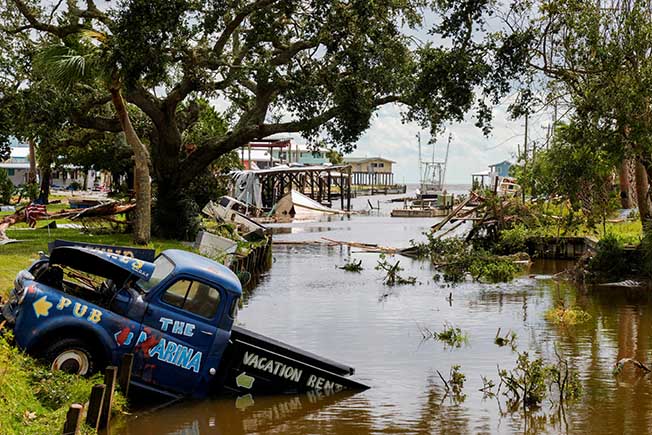Cleanup and recovery from Hurricane Idalia began on Thursday along Florida’s Gulf Coast, where property damage, loss of life and power disruptions paled in comparison to the last major hurricane that struck the state nearly a year ago.
Idalia crashed ashore on Wednesday morning as a powerful Category 3 hurricane at Keaton Beach in Florida’s Big Bend region, lashing the coast with sustained winds of up to 125 miles per hour (201 kph), accompanied by torrential rains and pounding surf.
The surge of storm-driven seawater rushed inland for miles, flooding low-lying communities and roadways in its path.
But Florida Governor Ron DeSantis said hours later that no deaths had been reported from the storm surge, considered the potentially most lethal hazard posed by a major hurricane.
National Guard troops pulled stranded motorists to safety from their vehicles in Taylor and Hernando counties, while emergency teams plying submerged streets in boats rescued dozens of people from floodwaters in St. Petersburg, about 200 miles south of the landfall zone.
Similar boat rescues of residents trapped by floodwaters in their homes were conducted in at least one town in the neighboring state of Georgia, where Idalia turned its fury as it weakened and drifted northward out of Florida.
By nightfall, authorities were still trying to assess the full extent of damage.
Insured property losses in Florida were projected to run $9.36 billion, investment bank UBS said in a research note based on preliminary estimates.
Electricity outages from fallen trees, utility poles and power lines were widespread, as were wind-damaged and flooded buildings, in hard-hit communities such as Perry, a city about 20 miles inland and north of where Idalia came ashore.
FEW ‘BAD NEWS’ CALLS
Still, Idalia was far less expansive, destructive or lethal than Hurricane Ian, a Category 5 storm that struck Florida in September 2022, causing 150 deaths and $112 billion in damage, according to U.S. government figures.
“The bad news type calls we were accustomed to during Ian, those were not happening during this storm,” DeSantis said at a late-afternoon news conference on Wednesday.
He said no hurricane fatalities had been confirmed from Idalia and that it appeared most residents in vulnerable, low-lying areas had heeded evacuation orders and warnings to move to higher ground.
Florida Highway Patrol reported that two motorists had died in separate rain-related crashes early Wednesday before Idalia made landfall. DeSantis later said state authorities were investigating one unconfirmed storm-related traffic death.
BIG BEND TAKES BIGGEST HIT
As predicted, the brunt of the storm was borne in the heart of Florida’s largely rural Big Bend region, where the state’s northern Gulf Coast panhandle curves into the western side of the Florida Peninsula. The area is roughly bounded by the cities of Gainesville and Tallahassee, the state capital.
The same region, featuring a marshy coast and threaded with freshwater springs and rivers, was devastated by a major hurricane in 1896.
But severe impacts of Idalia were not confined to the Big Bend. In Hillsborough County, an area of 1.5 million people well to the south that includes Tampa, crews were dealing with widespread damage and flooded streets, officials said in a news briefing.
The governor said that as many as 565,000 utility customers across the state had lost electricity at some point during and after the storm. As of 9 p.m., power had been restored to all but 175,000, he said later.
One measure of the catastrophic blow that Florida was spared on Wednesday came from an assessment given by Jared Perdue, the head of the state’s Transportation Department. He said a survey of the worst-hit areas found that what they needed most was to get their traffic lights restored and debris removed, along with more generators.
All state bridges in storm-stricken areas had since been examined and cleared for use, and most of the 52 school districts that closed ahead of the storm planned to reopen on Thursday, officials said.
While Idalia proved less formidable than was feared, the storm also illustrated an increasing trend of rapidly intensifying cyclonic storms, a phenomenon scientists say is symptomatic of climate change.
Feeding on the warm, open waters of the Gulf of Mexico, Idalia quickly gained strength as it churned toward Florida after skirting the western tip of Cuba on Monday as a tropical storm.
Idalia reached hurricane strength on Tuesday and attained Category 4 intensity on the five-step Saffir-Simpson wind scale early Wednesday before landfall, but by 7 a.m. had weakened into Category 3, according to the National Hurricane Center.
As it entered southeastern Georgia, Idalia’s wind speeds ebbed to 90 mph, reducing the tempest to Category 1. By 5 p.m. EDT, it weakened further into a tropical storm, the NHC reported.
Exiting Georgia on Wednesday night, Idalia was expected to drift along the South Carolina coast through much of Thursday before curling eastward off North Carolina and out into the Atlantic on Thursday night, the NHC said.
One non-human casualty of the storm in Florida was a century-old oak tree that toppled onto the governor’s mansion in Tallahassee. A post on the X social media platform by Florida first lady Casey DeSantis showed the giant tree split in two, with one half appearing to have fallen atop the white-pillared residence. She said no one was hurt.


